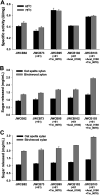Coexpression of a β-d-Xylosidase from Thermotoga maritima and a Family 10 Xylanase from Acidothermus cellulolyticus Significantly Improves the Xylan Degradation Activity of the Caldicellulosiruptor bescii Exoproteome
- PMID: 33990300
- PMCID: PMC8231722
- DOI: 10.1128/AEM.00524-21
Coexpression of a β-d-Xylosidase from Thermotoga maritima and a Family 10 Xylanase from Acidothermus cellulolyticus Significantly Improves the Xylan Degradation Activity of the Caldicellulosiruptor bescii Exoproteome
Abstract
Caldicellulosiruptor species are hyperthermophilic, Gram-positive anaerobes and the most thermophilic cellulolytic bacteria so far described. They have been engineered to convert switchgrass to ethanol without pretreatment and represent a promising platform for the production of fuels, chemicals, and materials from plant biomass. Xylooligomers, such as xylobiose and xylotriose, that result from the breakdown of plant biomass more strongly inhibit cellulase activity than do glucose or cellobiose. High concentrations of xylobiose and xylotriose are present in C. bescii fermentations after 90 h of incubation, and removal or breakdown of these types of xylooligomers is crucial to achieving high conversion of plant biomass to product. In previous studies, the addition of exogenous β-d-xylosidase substantially improved the performance of glucanases and xylanases in vitro. β-d-Xylosidases are, in fact, essential enzymes in commercial preparations for efficient deconstruction of plant biomass. In addition, the combination of xylanase and β-d-xylosidase is known to exhibit synergistic action on xylan degradation. In spite of its ability to grow efficiently on xylan substrates, no extracellular β-d-xylosidase was identified in the C. bescii genome. Here, we report that the coexpression of a thermal stable β-d-xylosidase from Thermotoga maritima and a xylanase from Acidothermus cellulolyticus in a C. bescii strain containing the A. cellulolyticus E1 endoglucanase significantly increased the activity of the exoproteome as well as growth on xylan substrates. The combination of these enzymes also resulted in increased growth on crystalline cellulose in the presence of exogenous xylan. IMPORTANCECaldicellulosiruptor species are bacteria that grow at extremely high temperature, more than 75°C, and are the most thermophilic bacteria so far described that are capable of growth on plant biomass. This native ability allows the use of unpretreated biomass as a growth substrate, eliminating the prohibitive cost of preprocessing/pretreatment of the biomass. They only grow under strictly anaerobic conditions, and the combination of high temperature and the lack of oxygen reduces the cost of fermentation and contamination by other microbes. They have been genetically engineered to convert switchgrass to ethanol without pretreatment and represent a promising platform for the production of fuels, chemicals, and materials from plant biomass. In this study, we introduced genes from other cellulolytic bacteria and identified a combination of enzymes that improves growth on plant biomass. An important feature of this study is that it measures growth, validating predictions made from adding enzyme mixtures to biomass.
Keywords: Caldicellulosiruptor; biomass deconstruction; consolidated bioprocessing; xylanase; β-d-xylosidase.
Figures





Similar articles
-
Heterologous expression of family 10 xylanases from Acidothermus cellulolyticus enhances the exoproteome of Caldicellulosiruptor bescii and growth on xylan substrates.Biotechnol Biofuels. 2016 Aug 22;9(1):176. doi: 10.1186/s13068-016-0588-9. eCollection 2016. Biotechnol Biofuels. 2016. PMID: 27555882 Free PMC article.
-
Expression of a Cellobiose Phosphorylase from Thermotoga maritima in Caldicellulosiruptor bescii Improves the Phosphorolytic Pathway and Results in a Dramatic Increase in Cellulolytic Activity.Appl Environ Microbiol. 2018 Jan 17;84(3):e02348-17. doi: 10.1128/AEM.02348-17. Print 2018 Feb 1. Appl Environ Microbiol. 2018. PMID: 29101202 Free PMC article.
-
Heterologous expression of a β-D-glucosidase in Caldicellulosiruptor bescii has a surprisingly modest effect on the activity of the exoproteome and growth on crystalline cellulose.J Ind Microbiol Biotechnol. 2017 Dec;44(12):1643-1651. doi: 10.1007/s10295-017-1982-4. Epub 2017 Sep 23. J Ind Microbiol Biotechnol. 2017. PMID: 28942503
-
Genomics review of holocellulose deconstruction by aspergilli.Microbiol Mol Biol Rev. 2014 Dec;78(4):588-613. doi: 10.1128/MMBR.00019-14. Microbiol Mol Biol Rev. 2014. PMID: 25428936 Free PMC article. Review.
-
Metabolic engineering of Caldicellulosiruptor bescii for hydrogen production.Appl Microbiol Biotechnol. 2024 Dec;108(1):65. doi: 10.1007/s00253-023-12974-7. Epub 2024 Jan 9. Appl Microbiol Biotechnol. 2024. PMID: 38194138 Free PMC article. Review.
Cited by
-
Integrating multi-platform assembly to recover MAGs from hot spring biofilms: insights into microbial diversity, biofilm formation, and carbohydrate degradation.Environ Microbiome. 2024 May 6;19(1):29. doi: 10.1186/s40793-024-00572-7. Environ Microbiome. 2024. PMID: 38706006 Free PMC article.
-
Engineering Caldicellulosiruptor bescii with Surface Layer Homology Domain-Linked Glycoside Hydrolases Improves Plant Biomass Solubilization.Appl Environ Microbiol. 2022 Oct 26;88(20):e0127422. doi: 10.1128/aem.01274-22. Epub 2022 Sep 28. Appl Environ Microbiol. 2022. PMID: 36169328 Free PMC article.
-
Engineering the Metabolic Landscape of Microorganisms for Lignocellulosic Conversion.Microorganisms. 2023 Aug 31;11(9):2197. doi: 10.3390/microorganisms11092197. Microorganisms. 2023. PMID: 37764041 Free PMC article. Review.
-
Biochemical and Regulatory Analyses of Xylanolytic Regulons in Caldicellulosiruptor bescii Reveal Genus-Wide Features of Hemicellulose Utilization.Appl Environ Microbiol. 2022 Nov 8;88(21):e0130222. doi: 10.1128/aem.01302-22. Epub 2022 Oct 11. Appl Environ Microbiol. 2022. PMID: 36218355 Free PMC article.
References
-
- Yang SJ, Kataeva I, Hamilton-Brehm SD, Engle NL, Tschaplinski TJ, Doeppke C, Davis M, Westpheling J, Adams MW. 2009. Efficient degradation of lignocellulosic plant biomass, without pretreatment, by the thermophilic anaerobe “Anaerocellum thermophilum” DSM 6725. Appl Environ Microbiol 75:4762–4769. 10.1128/AEM.00236-09. - DOI - PMC - PubMed
-
- Lochner A, Giannone RJ, Rodriguez M, Jr, Shah MB, Mielenz JR, Keller M, Antranikian G, Graham DE, Hettich RL. 2011. Use of label-free quantitative proteomics to distinguish the secreted cellulolytic systems of Caldicellulosiruptor bescii and Caldicellulosiruptor obsidiansis. Appl Environ Microbiol 77:4042–4054. 10.1128/AEM.02811-10. - DOI - PMC - PubMed
-
- Dam P, Kataeva I, Yang SJ, Zhou FF, Yin YB, Chou WC, Poole FL, Westpheling J, Hettich R, Giannone R, Lewis DL, Kelly R, Gilbert HJ, Henrissat B, Xu Y, Adams MWW. 2011. Insights into plant biomass conversion from the genome of the anaerobic thermophilic bacterium Caldicellulosiruptor bescii DSM 6725. Nucleic Acids Res 39:3240–3254. 10.1093/nar/gkq1281. - DOI - PMC - PubMed
-
- Chung D, Young J, Cha M, Brunecky R, Bomble YJ, Himmel ME, Westpheling J. 2015. Expression of the Acidothermus cellulolyticus E1 endoglucanase in Caldicellulosiruptor bescii enhances its ability to deconstruct crystalline cellulose. Biotechnol Biofuels 8:113. 10.1186/s13068-015-0296-x. - DOI - PMC - PubMed
Publication types
MeSH terms
Substances
Supplementary concepts
LinkOut - more resources
Full Text Sources
Other Literature Sources

